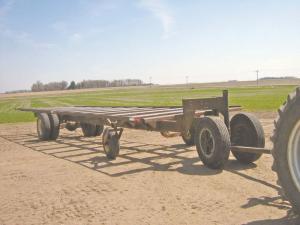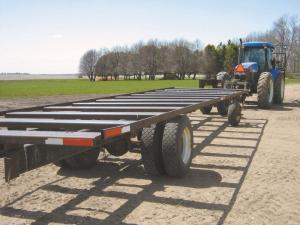Bus Bale Wagon Turns On A Dime
Jerry Ackermann’s bale wagon makes hay movement easy and keeps heavy semis off the field. That is important when harvesting 350 to 400 acres of alfalfa a year. The wagon, converted from an old school bus, went through 2 modifications the first year, and has worked great for the past 14 years.
“I looked at a commercial bale wagon, but they wanted more than $16,000 and that was 15 years ago,” says Ackermann. “I saw a bale wagon a guy had converted from a school bus and decided to try it.”
He stripped the school bus down to frame and axles before adding a bed made with 3 by 12-in. channel irons. Ackermann picked them up at scrap price after a manufacture miss-stamped them and was unable to use them. Initially he attached a tongue to the front axle for towing.
“We used it that way for the first cutting, but the turning radius was way to wide,” recalls Ackermann. “I took it to a local machine shop, and they suggested removing the front axle and using a pedestal pivot instead. They built it out of heavy steel and thick wall pipe. We cut the axle stubs from the front axle of the bus and welded them to the pedestal.”
When Ackermann returned to the field for second cutting, the turning radius benefit was immediate. He was able to turn at a 90-degree angle or better. However, when turning with a bale on one front corner or the other, he noticed a tendency for the wagon to twist.
“I had an old IH Cyclo planter sitting in the grove, so we chopped off the lift assist wheels and welded them to the front corners of the wagon,” recalls Ackermann. “They stabilize the wagon on tight turns and spread the load out even more.”
With the stabilizers in place and the pedestal front end, Ackermann can carry twenty-four 1,000-lb. bales at a time out of the field. He stacks them 3 wide and 2 high on the 38-ft. long bed.
“We could stack them even higher, but as it is, they can leave tracks in the field, which I don’t like to see,” says Ackermann. “Fully loaded, the bales can rub on the tires so I welded stops in so the springs can only depress so far. Going slow in the field, that’s not a problem. It’s really not built to travel at road speeds.”
Ackermann uses the bale wagon to carry bales to semis parked at the edge of the field. He equipped his bidirectional loader tractor with an Agri-Speed hitch so he can unhook without leaving the tractor, load the wagon, and unload again at the semis.
“The 3-pt. is programmed to stop at the right level for hooking up, but with the bidirectional, it’s hard to see to line up the hitch,” says Ackermann. “We added a camera so we can see clearly. We also hooked the cable for releasing the hitch to the top link by a spring. The spring takes the shock off the cable when the 3-pt. is raised to release the hitch.”
Contact: FARM SHOW Followup, Jerry Ackermann, 39750 820th St., Lakefield, Minn. 56150 (ph 507 662-5577; ackermann.jn@gmail.com).

Click here to download page story appeared in.
Click here to read entire issue
Bus Bale Wagon Turns On A Dime BALE HANDLING Jerry Ackermann’s bale wagon makes hay movement easy and keeps heavy semis off the field That is important when harvesting 350 to 400 acres of alfalfa a year The wagon converted from an old school bus went through 2 modifications the first year and has worked great for the past 14 years
“I looked at a commercial bale wagon but they wanted more than $16 000 and that was 15 years ago ” says Ackermann “I saw a bale wagon a guy had converted from a school bus and decided to try it ”
He stripped the school bus down to frame and axles before adding a bed made with 3 by 12-in channel irons Ackermann picked them up at scrap price after a manufacture miss-stamped them and was unable to use them Initially he attached a tongue to the front axle for towing
“We used it that way for the first cutting but the turning radius was way to wide ” recalls Ackermann “I took it to a local machine shop and they suggested removing the front axle and using a pedestal pivot instead They built it out of heavy steel and thick wall pipe We cut the axle stubs from the front axle of the bus and welded them to the pedestal ”
When Ackermann returned to the field for second cutting the turning radius benefit was immediate He was able to turn at a 90-degree angle or better However when turning with a bale on one front corner or the other he noticed a tendency for the wagon to twist
“I had an old IH Cyclo planter sitting in the grove so we chopped off the lift assist wheels and welded them to the front corners of the wagon ” recalls Ackermann “They stabilize the wagon on tight turns and spread the load out even more ”
With the stabilizers in place and the pedestal front end Ackermann can carry twenty-four 1 000-lb bales at a time out of the field He stacks them 3 wide and 2 high on the 38-ft long bed
“We could stack them even higher but as it is they can leave tracks in the field which I don’t like to see ” says Ackermann “Fully loaded the bales can rub on the tires so I welded stops in so the springs can only depress so far Going slow in the field that’s not a problem It’s really not built to travel at road speeds ”
Ackermann uses the bale wagon to carry bales to semis parked at the edge of the field He equipped his bidirectional loader tractor with an Agri-Speed hitch so he can unhook without leaving the tractor load the wagon and unload again at the semis
“The 3-pt is programmed to stop at the right level for hooking up but with the bidirectional it’s hard to see to line up the hitch ” says Ackermann “We added a camera so we can see clearly We also hooked the cable for releasing the hitch to the top link by a spring The spring takes the shock off the cable when the 3-pt is raised to release the hitch ”
Contact: FARM SHOW Followup Jerry Ackermann 39750 820th St Lakefield Minn 56150 ph 507 662-5577; ackermann jn@gmail com
To read the rest of this story, download this issue below or click
here to register with your account number.








